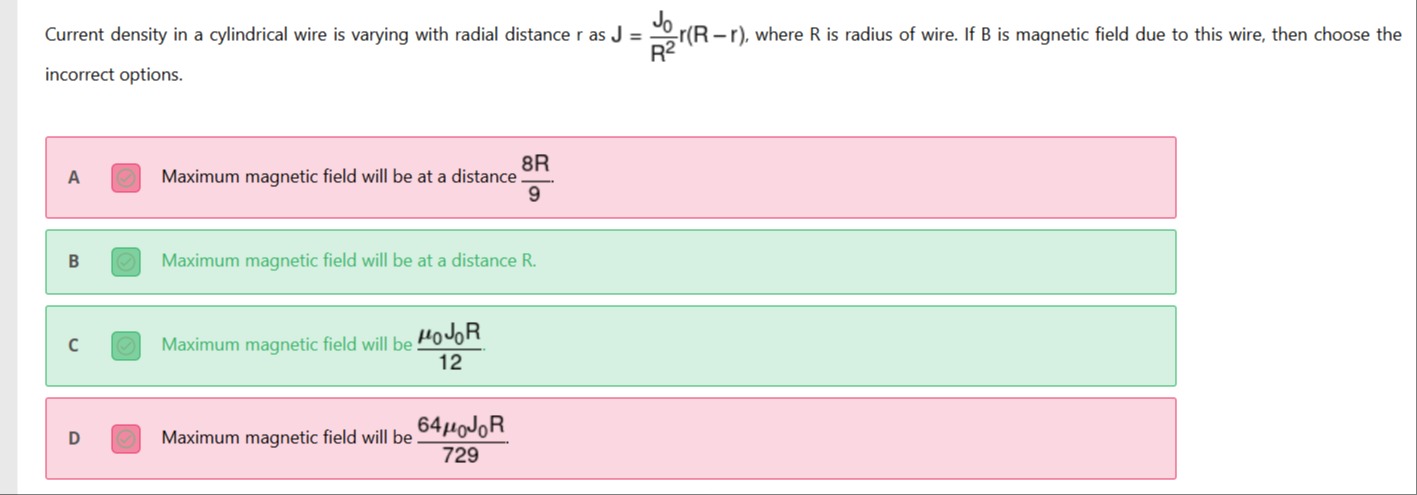Question
Question: Current density in a cylindrical wire is varying with radial distance r as $J = \frac{J_0}{R^2}r(R-r...
Current density in a cylindrical wire is varying with radial distance r as J=R2J0r(R−r), where R is radius of wire. If B is magnetic field due to this wire, then choose the incorrect options.

Maximum magnetic field will be at a distance 98R
Maximum magnetic field will be at a distance R.
Maximum magnetic field will be 12μ0J0R
Maximum magnetic field will be 72964μ0J0R
B, C
Solution
The current density in the cylindrical wire is given by J=R2J0r(R−r), where R is the radius of the wire and r is the radial distance from the axis.
We use Ampere's Law to find the magnetic field B(r). For a circular Amperian loop of radius r centered on the axis, Ampere's Law is B(r)⋅2πr=μ0Ienc(r), where Ienc(r) is the current enclosed by the loop.
Case 1: Magnetic field inside the wire (r≤R)
The enclosed current is Ienc(r)=∫0rJ(r′)dA=∫0rR2J0r′(R−r′)(2πr′dr′).
Ienc(r)=R22πJ0∫0r(Rr′2−r′3)dr′=R22πJ0[3Rr′3−4r′4]0r=R22πJ0(3Rr3−4r4).
Using Ampere's Law, B(r)⋅2πr=μ0R22πJ0(3Rr3−4r4).
B(r)=R2μ0J0(3Rr2−4r3) for 0≤r≤R.
To find the maximum magnetic field inside the wire, we differentiate B(r) with respect to r and set it to zero.
drdB=R2μ0J0(32Rr−43r2).
Setting drdB=0 gives 32Rr−43r2=0, which factors as r(32R−43r)=0.
This gives r=0 or 32R=43r, so r=98R.
The value r=98R is within the wire (0<98R<R).
We can check the second derivative or the values at critical points and boundaries.
B(0)=0.
B(R)=R2μ0J0(3R(R)2−4R3)=R2μ0J0(3R3−4R3)=R2μ0J012R3=12μ0J0R.
B(98R)=R2μ0J0(3R(98R)2−41(98R)3)=R2μ0J0(3R8164R2−41729512R3)
B(98R)=R2μ0J0(24364R3−729128R3)=μ0J0R(24364−729128)=μ0J0R(729192−128)=72964μ0J0R.
Comparing B(98R) and B(R): 72964≈0.08779 and 121≈0.08333. Since 72964>121, the maximum magnetic field inside the wire occurs at r=98R.
Case 2: Magnetic field outside the wire (r>R)
The total current flowing through the wire is Itotal=Ienc(R)=R22πJ012R4=6πJ0R2.
For r>R, B(r)⋅2πr=μ0Itotal=μ06πJ0R2.
B(r)=12rμ0J0R2 for r>R.
This function decreases as r increases for r>R. The maximum value for r≥R occurs at r=R, which is B(R)=12μ0J0R.
Comparing the maximum value inside the wire B(98R)=72964μ0J0R with the maximum value outside (which occurs at the surface) B(R)=12μ0J0R, we found that B(98R)>B(R).
Thus, the overall maximum magnetic field occurs at r=98R and its value is 72964μ0J0R.
Now let's evaluate the options:
A Maximum magnetic field will be at a distance 98R. This is correct.
B Maximum magnetic field will be at a distance R. This is incorrect. The maximum is at r=98R.
C Maximum magnetic field will be 12μ0J0R. This is incorrect. This is the value at r=R, not the maximum value.
D Maximum magnetic field will be 72964μ0J0R. This is correct. This is the value at r=98R.
The question asks for the incorrect options. Options B and C are incorrect.
